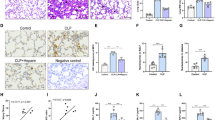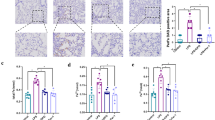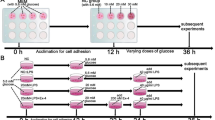Abstract
Purpose. To demonstrate that rat alveolar macrophages (AM) exhibited the PepT1-like transporter for the uptake of arginine (Arg)-containing small peptides and utilized these peptides as direct substrates for nitric oxide (NO) production. NO is an important mediator that, on one hand, protects the lung from bacteria infection and, on the other hand, augments inflammatory lung injury.
Method. The uptake of small peptides by rat AM was evaluated using fluorescein isothiocyanate (FITC)-labeled (*) peptides (Arg-Lys*, Gly-Sar-Lys*, and β-Ala-Lys*), high-performance liquid chromatography (HPLC) analysis of potential peptide degradation, and known inhibitors of Arg and PepT1 transport. NO production by AM through Arg and Arg-containing peptides was studied with and without inhibition by transport inhibitors. The presence of PepT1-like transporter on AM was evaluated using anti-PepT1 antisera and Western blot analysis. The substrate specificity of Arg-Gly and Arg-Gly-Asp was determined using purified inducible NO synthase (iNOS). The availability of Arg-containing peptides in the lung was determined by HPLC analysis of bronchoalveolar lavage (BAL) fluid.
Results. The FITC-labeled peptides were internalized by AM without degradation. The uptake of Arg-Lys*, β-Ala-Lys*, and Gly-Sar-Lys* was blocked (∼50%) by cephradine (an inhibitor of PepT1 for peptide transport) but not by Lys (an inhibitor on cationic amino acid transporter 2B for Arg transport). The NO production by AM through Arg-containing peptides was significantly blocked only by PepT1 inhibitors and by an anti-PepT1 antibody in a dose-dependent manner. These inhibitors had no effect on the AM production of NO using Arg as a substrate. Arg-Gly and Arg-Gly-Asp were found to be direct substrates for iNOS with similar Km and Vmax values to those of Arg. But, the production of NO by AM using these peptides as substrates was 2-fold higher than using Arg as a substrate. Both Arg-Gly and Arg-Gly-Asp were found in the BAL fluid. The presence of a PepT1-like transporter on AM was confirmed by Western blotting.
Conclusion. This study shows that AM exhibit PepT1-like transporter for small peptide uptake. Arginine-containing peptides, through the PepT1 transporter system, can serve as direct substrates of iNOS for the production of NO by AM.
Similar content being viewed by others
REFERENCES
Seal, C. J. and Parker, D. S. Isolation and characterization of circulating low molecular weight peptides in steer, sheep and rat portal and peripheral blood. Comp. Biochem. Physiol. 99:679–685 (1991).
H. Lochs, P. E. Williams, E. E. Morse, N. N. Abumrad, and S. A. Adibi. Metabolism of dipeptide and their constituent amino acids by liver, gut, kidney, and muscle. J. Am. Physiol. 254:E587–E594 (1988).
B. A. Krzysik and S. A. Adibi. Cytoplasmic dipeptidase activities of kidney, ileum, jejunum, liver, muscle, and blood. Am. J. Physiol. 233:E450–E456 (1977).
M. E. McCormick and K. E. Webb, Jr. Plasma free, erythrocyte free and plasma peptide amino acid exchange to calves in steady state and fasting metabolism. J. Nutr. 112::276–282 (1982).
Y. J. Fei, Y. Kanal, S. Nussberger, V. Ganapathy, F. Leibach, M. F. Romero, S. K. Singh, M. F. Boron, and M. A. Hediger. Expression cloning of a mammalian proton-coupled oligopeptide transporter. Nature 368:563–566 (1994).
S. Wang, K. E. Webb, Jr., and M. R. Akers. Peptide-bond methionine can be a source of methionine for the synthesis of secreted proteins by mammary tissue explants from lactating mice. J. Nutr. 126:1662–1672 (1996).
K. P. Beckerman, H. W. Rogers, J. A. Corbett, R. D. Schreiber, M. L. McDaniel, and E. R. Unanue. Release of nitric oxide during the T cell-independent pathway of macrophage activation: Its role in resistance to Listeria monocytogenes. J. Immunol. 150:888–895 (1993).
G. M. Raso, R. Meli, G. Di Carlo, M. Pacilio, and R. Di Carlo. Inhibition of inducible nitric oxide synthase and cyclooxygenase-2 expression by flavonoids in macrophage J774A.1. Life Sci. 68:921–931 (2001).
M. Caivano. Role of MAP kinase cascades in inducing arginine transporters and nitric oxide synthetase in RAW264 macro-phages. FEBS Lett. 429:249–253 (1998).
D. K. Kakuda, M. J. Sweet, C. L. MacLeod, D. A. Hume, and D. Markovich. CAT2-mediated L-arginine transport and nitric oxide production in activated macrophages. Biochem. J. 340:549–553 (1999).
C. Thiemermann, M. Mustafa, P. A. Mester, J. A. Mitchell, M. Hecker, and J. R. Vane. Inhibition of the release of endothelium-derived relaxing factor in vitro and in vivo by dipeptides containing NG-nitro-L-arginine. Br. J. Pharmacol. 104:31–38 (1991).
D. Meredith and C. A. R. Boyd. Dipeptide transport characteristics of the apical membrane of rat lung type II pneumocytes. Am. J. Physiol. 269:137–143 (1995).
D. A. Groneberg, M. Nickolaus, J. Springer, F. Doring, H. Daniel, and A. Fischer. Localization of the peptide transporter PEPT2 in the lung: Implications for pulmonary oligopeptide uptake. Am. J. Pathol. 158:707–714 (2001).
K. Miyamoto, T. Shiraga, K. Morita, H. Yamamoto, H. Haga, Y. Taketani, I. Tamai, Y. Sai, A. Tsuji, and E. Takeda. Sequence, tissue distribution and developmental changes in rat intestinal oligopeptide transporter. Biochim. Biophys. Acta 1305:34–38 (1996).
F. C. Lane and J. R. Mehta. In vitro human tumor sensitivity assay using cell counting and sizing. Am. Biotechnol. Lab. 8:12–27 (1990).
L. C. Green. Analysis of nitric oxide, nitrite, and [15N] nitrate in biologic fluids. Anal. Biochem. 126:131–138 (1982).
D. J. Stuehr, H. J. Cho, N. S. Kwon, M. F. Weise, and C. F. Nathan. Purification and characterization of the cytokineinduced macrophage nitric oxide synthase: an FAD-and FMN-containing flavoprotein. Proc. Natl. Acad. Sci. U S A 88:7773–7777 (1991).
C. L. Su and R. E. Austic. The utilization of dipeptides containing L-arginine by chicken macrophages. Poult. Sci. 77:1852–1857 (1998).
H. Saito, T. Terada, M. Okuda, S. Sasaki, and K. Inui. Molecular cloning and tissue distribution of rat peptide transporter PEPT2. Biochim. Biophys. Acta 1280:173–177 (1996).
J. M. Hevel, K. A. White, and M. A. Marletta. Purification of the inducible murine macrophage nitric oxide synthase: Identification as a flavoprotein. J. Biol. Chem. 266:22789–22791 (1991).
A. Barbul. Nitric oxide from L-Arginine: A Bioregulatory System. In S. Moncada and E. A. Higgs (eds.), Physiology and Pharmacology of Aginine, Elsevier Science, New York, 1990 p. 318.
K. S. Boockvar, D. L. Granger, R. M. Poston, M. Maybodi, M. K. Washington, J. B. Hibbs, Jr., and R. L. Kurlander. Nitric oxide produced during murine listeriosis is protective. Infect. Immun. 62:1089–1100 (1994).
K. Kikuta, T. Sawamura, S. Miwa, N. Hashimoto, and T. Masaki. High-affinity arginine transport of bovine aortic endothelial cells is impaired by lysophosphatidylcholine. Circ. Res. 83:1088–1096 (1998).
Author information
Authors and Affiliations
Corresponding author
Rights and permissions
About this article
Cite this article
Yang, XD., Ma, J.Y.C., Barger, M.W. et al. Transport and Utilization of Arginine and Arginine-Containing Peptides by Rat Alveolar Macrophages. Pharm Res 19, 825–831 (2002). https://doi.org/10.1023/A:1016132200104
Issue Date:
DOI: https://doi.org/10.1023/A:1016132200104




